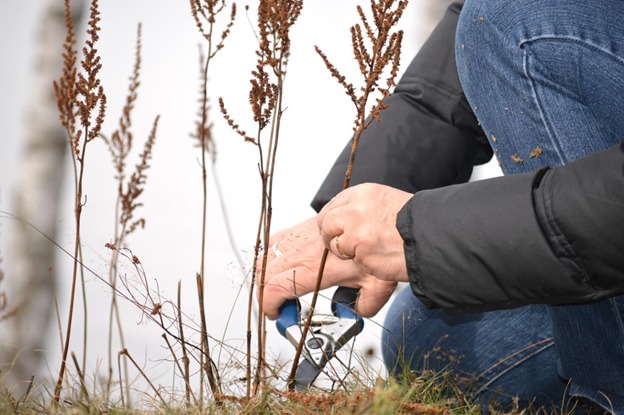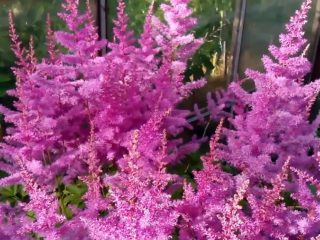Content
Astilbe America is loved by many gardeners due to its unpretentiousness, love of shaded areas and ease of care. It is considered an ideal plant for open ground. It easily tolerates frost, blooms profusely and decorates summer cottages.

Astilbe can have pink and bright red inflorescences
Description of Astilbe Arends America
Astilbe "Arendsa America" is a perennial plant. It has erect stems that die off in winter. The length of the shoots, depending on the variety, varies from 10 cm to 1.5 meters. The root system continues to develop despite winter frosts.
Green leaves, carved. In spring, their edges take on a brown color. Length reaches 40 cm.
Bushes can be compact, but more often take on a spreading form. Openwork foliage gives a beautiful appearance to Astilbe “America” even without inflorescences.
Astilbe is a shade-tolerant plant type.
The bushes also take root in direct sunlight. In this case, they require frequent watering and spraying.

The plant feels best in partial shade or in a place with diffused light.
Astilbe "America" grows quickly and forms into a bush.Already in the first year it can please you with flowering.
With the onset of autumn cold weather, Astilbe "America" stops blooming; gardeners must promptly cut off flowering shoots. The stems continue to decorate the area with green foliage for a long time.
Some varieties can adapt to cold conditions. They can survive in regions of Siberia and the Urals, where winters are long and harsh.
Astilbe "America" tolerates ground freezing down to -22 ˚С, and external frosts up to -36 degrees. It is saved from death by the top layer of snow and mulching after pruning the plant.
Features of flowering
Astilbe belongs to the herbaceous plants of the Saxifraga family. The flowering period occurs in the summer months, the plant begins to bloom from late June to mid-August. At the end of the flowering of astilbe, a box with seeds is formed.
The inflorescence forms spreading panicles up to 60 cm long, which consist of many small flowers.
Astilbe "America" differs in the shape of the inflorescences; there are 4 of them:
- Paniculate shape.
- Drooping.
- Pyramidal.
- Rhombic.
The color of astilbe "America" can be light lilac, white, red and pink.
To ensure the plant has a presentable appearance and abundant flowering, you need to provide it with proper care:
- Every year you need to fill up the exposed areas of the root system.
- Maintain the required level of moisture in the soil.
- Mulch the soil in a timely manner.
- Fertilize regularly.
Application in design
Astilbe "America" is often used to decorate the landscape. Designers prefer it for its beauty, durability and ease of care.It can become a decoration for any flower garden.

Astilbe gets along well next to other vegetation
Astilbe "America" gets along with conifers (arborvitae, junipers), and can also exist next to ferns and hostas. The carved green leaves of astilbe combine beautifully with the large foliage of hellebore, cuff, bergenia and Rogers. In landscape design for decoration, it is planted next to lilies, geraniums and daylilies. It looks great in the spring garden and grows next to snowdrops, lilies of the valley, crocuses and tulips.
Reproduction methods
Gardeners have three ways to propagate plants:
- Seeds. This is not the best way to preserve the characteristics of the variety. For this method, it is enough to sow the seeds in spring or autumn on top of the soil; there is no need to dig in. Sprouted astilbe sprouts are picked, planted for growing, and then transferred to a permanent place. In winter they are covered.
- Dividing rhizomes. It is considered the most reliable way. Astilbe "America" is divided so that each part has at least three buds. The cut is sprinkled with ash, and the sprout is planted in previously prepared soil.
- Kidney renewal. In the spring, during the active growth period, buds with a small section of tissue are cut from the plant, then planted in prepared greenhouses with a peat-sand mixture. After three weeks, astilbe “America” takes root. A year later, the first inflorescences appear.
Planting and caring for astilbe America
Astilbe Arends America does not require special care. It is planted in May or June in a shaded area; some species can take root in a sunny place, but then the flowering period will be shortened.
When choosing planting material, you should carefully examine the root system and stems. The roots should not have rotten or dry areas; unsuitable specimens must be cut off. Sprouts released into the ground will take root faster if the buds are small.
Landing algorithm:
- Prepare a hole no more than 30 cm deep.
- Fertilizer is added to it and watered.
- The plant is planted at the top buds.
- Mulch on top.
A distance of 50-60 cm should be maintained between tall varieties; 25-45 cm is enough for low-growing varieties.

For the winter, it is advisable to cover the plant with spruce branches.
When caring for it, it is important to follow the basic rules of watering, fertilizing, mulching and pruning.
Features of cultivation
This flower needs a sufficient amount of moisture during any growing season. In dry times, astilbe "America" is watered several times a day (morning and evening). It is advisable to do this with settled water.
Particular attention is paid to feeding. In spring, astilbe "America" needs nitrogen fertilizers (can be fertilized with humus during hilling). In June you need to apply fertilizer containing potassium. At the end of flowering, the plant needs phosphorus.
Mulching helps retain moisture and protect against weeds.
Loosening the top layer of soil prevents the soil from forming a crust and allows the roots to “breathe.” It is necessary to loosen 2-3 times a season, no deeper than 10 cm.
Preparing for winter
Potassium and phosphorus fertilizers in the fall increase the level of frost resistance of the plant.Astilbe "America" loves soil with humus, so before winter you can add organic fertilizer. The slow decomposition of the fertilizer will allow it to acquire the necessary elements during flowering, which promotes growth and lush flowering.

In preparation for wintering, the stem is cut almost to the very root.
The ground is mulched with leaves and sawdust or peat. Such shelter helps to survive frosts. New buds will form in the upper part of the rhizome, which will begin to develop with the arrival of warmer weather. You can also use bark and humus as a shelter. The mulch layer depends on the climate of the region and varies between 5-20 cm.
It is difficult to cover an adult plant with a developed root system with mulch, so in the fall you need to rejuvenate it by removing unnecessary roots.
Diseases and pests
Astilbe "America" is not susceptible to diseases and pests. If it is poorly cared for, it may develop root rot, bacterial spotting, or phytoplasma disease of viral etiology.
Bacterial spot disease is characterized by the appearance of dark spots on the foliage, which cause astilbe to wilt.
The following parasitic pests can be identified: root-knot and strawberry nematodes, slobbering pennies and small cicadas.
Conclusion
Astilbe America is a universal plant that will harmoniously fit into any landscape design. The unpretentious flower requires minimal care, which guarantees rapid growth and abundant flowering.
Reviews








